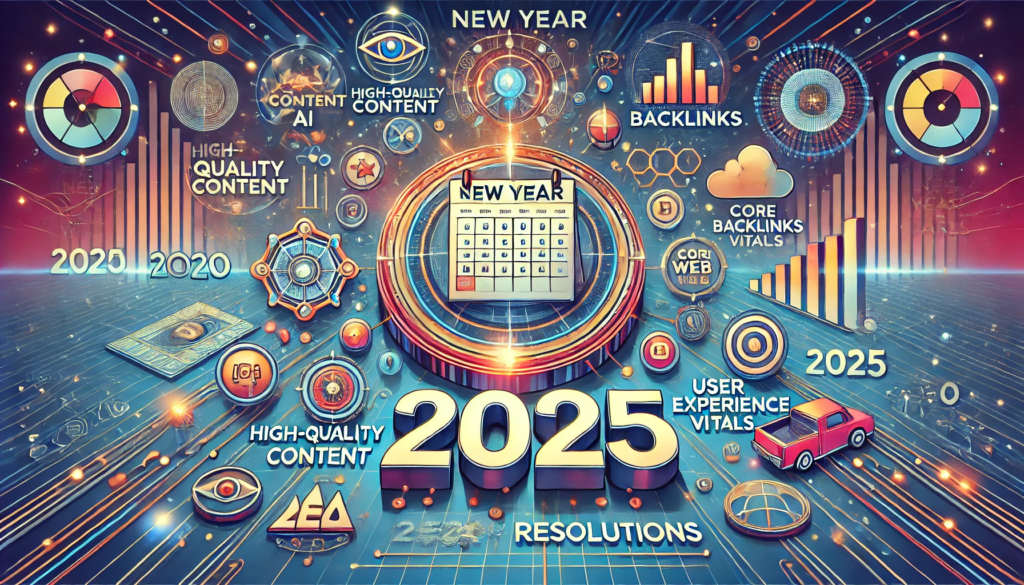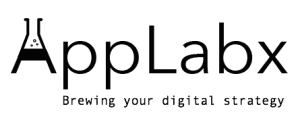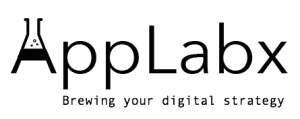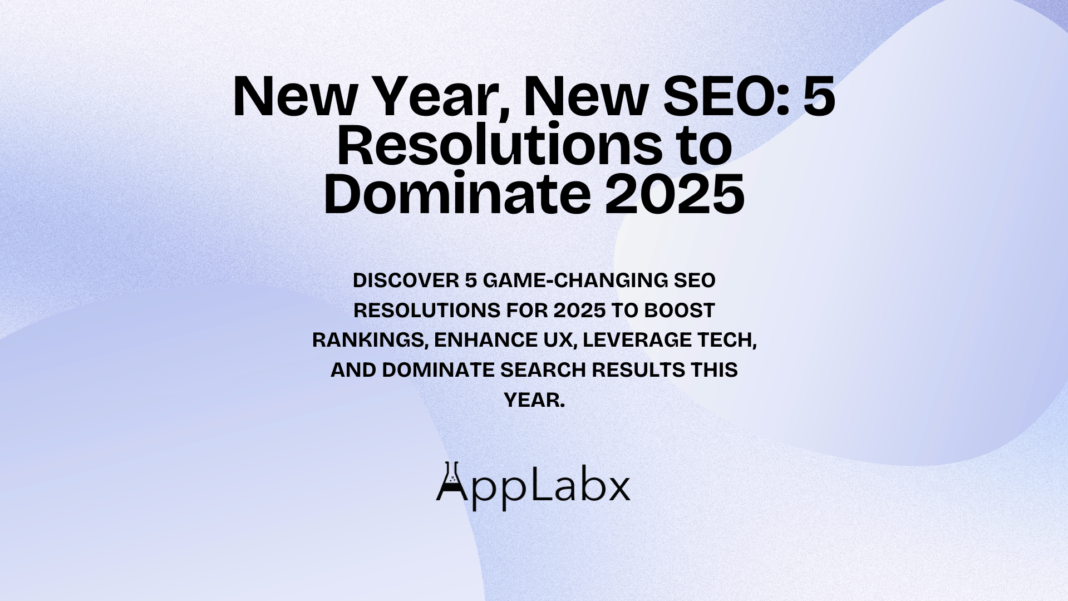Key Takeaways
- Prioritize High-Quality, Relevant Content: In 2025, creating valuable, user-focused content is crucial for driving traffic and improving search rankings.
- Embrace Emerging Technologies: Optimizing for AI, voice search, and other cutting-edge technologies will future-proof your SEO strategy and keep you ahead of the competition.
- Focus on User Experience and Core Web Vitals: Enhancing site speed, interactivity, and visual stability is essential for satisfying users and meeting Google’s ranking criteria.
As the clock strikes midnight on December 31st 2024, businesses worldwide shift their focus to the opportunities and challenges the New Year will bring.
For digital marketers, content creators, and entrepreneurs, this transition is the perfect time to reimagine strategies, set goals, and embrace the ever-changing dynamics of search engine optimization (SEO).

SEO, the backbone of digital visibility, is far from static.
With search engines continuously refining their algorithms, user behaviors evolving, and technologies like artificial intelligence (AI) reshaping the digital landscape, staying ahead of the curve requires more than just tweaking keywords.
It demands a proactive approach, one that anticipates trends, aligns with search engine expectations, and prioritizes user experience. As we step into 2025, the importance of a forward-thinking SEO strategy cannot be overstated.
Why should you care about updating your SEO practices for 2025?
The statistics speak for themselves. Studies show that 68% of online experiences begin with a search engine, and Google alone processes more than 8.5 billion searches every day.
This massive volume of activity highlights the immense potential SEO offers for driving traffic, building brand authority, and boosting conversions. However, with great opportunity comes fierce competition.
If your SEO strategy isn’t evolving, you risk losing visibility and relevance in a crowded digital marketplace.
The New Year presents the perfect opportunity to evaluate your current approach, identify gaps, and commit to actionable resolutions that will set you apart in 2025.
Whether you’re a seasoned SEO professional or a business owner dipping your toes into digital marketing, this guide will help you navigate the key shifts shaping the SEO landscape and provide clear, practical resolutions to dominate search rankings.
In this blog, we’ll explore five impactful resolutions designed to elevate your SEO game in 2025. From crafting high-quality content that aligns with user intent to leveraging cutting-edge technologies like AI and voice search, these strategies will empower you to stay ahead of the competition and deliver an exceptional online experience.
But before we dive into these resolutions, let’s take a moment to understand why 2025 is a pivotal year for SEO innovation.
Search engines are becoming smarter, focusing more on user satisfaction and relevance than ever before. Meanwhile, emerging trends such as conversational search, mobile-first indexing, and Core Web Vitals are reshaping how websites are ranked. With these changes on the horizon, businesses that embrace agility and foresight will thrive, while those clinging to outdated tactics risk falling behind.
So, let’s make 2025 the year you transform your SEO strategy from good to unbeatable. By committing to these five resolutions, you’ll not only adapt to the changes in search engine algorithms but also set the foundation for long-term success. After all, a new year is not just a chance to start fresh—it’s an opportunity to lead, innovate, and dominate in your niche.
Get ready to kickstart your journey with the first resolution: creating high-quality, relevant content that speaks to your audience and satisfies search engines alike. Let’s make this New Year the turning point for your SEO success story.
Why SEO Resolutions Matter in 2025
As search engines evolve and the digital landscape shifts, having a well-thought-out SEO strategy has never been more critical. Each year brings new challenges and opportunities for businesses aiming to maintain or improve their search rankings. By understanding the importance of adapting your SEO practices to align with current trends, you can position your brand for sustained growth and visibility in 2025. Let’s dive into why setting SEO resolutions for the new year is essential.
The Changing Landscape of Search Engine Algorithms
- Constant Algorithm Updates:
- Search engines like Google release frequent updates to enhance user experience. For example, Google’s Helpful Content Update emphasizes rewarding content that meets user intent.
- Neglecting these changes can lead to a drop in rankings, even for previously high-performing websites.
- AI Integration:
- AI tools like Google Bard and ChatGPT are influencing search behaviors. Tailoring your SEO strategy to align with these technologies ensures your content remains discoverable.
- Example: Websites that adopted structured data for better AI interpretation saw improved visibility in AI-generated search results.
Growing Trends That Are Reshaping SEO
- Voice Search:
- More users rely on smart assistants (e.g., Alexa, Google Assistant) for hands-free searches.
- Tip: Optimize content for conversational queries by targeting long-tail keywords.
- Example: A local bakery optimized for “Where can I find fresh croissants near me?” and experienced a 25% increase in traffic from voice searches.
- Mobile-First Indexing:
- Google now predominantly uses mobile versions of websites for indexing and ranking.
- Action: Ensure your site is responsive and performs well on all devices.
- Video Content’s Role in SEO:
- Video accounts for a significant portion of global internet traffic. Optimizing video descriptions, transcripts, and thumbnails can boost rankings.
- Example: A tech brand uploading SEO-optimized product tutorials saw a 50% increase in organic traffic.
User Expectations and Experience Are Evolving
- Focus on User Experience (UX):
- Websites with fast load times, intuitive navigation, and engaging layouts retain visitors and rank higher.
- Google’s Core Web Vitals now directly influence rankings, making UX improvements non-negotiable.
- Demand for Personalized Content:
- Users expect tailored experiences.
- Tip: Leverage analytics to understand user intent and provide personalized recommendations.
- Example: An e-commerce site that personalized product suggestions increased conversions by 20%.
The Competitive Nature of SEO in 2025
- More Players in the Game:
- Businesses of all sizes are recognizing the value of SEO, increasing competition across industries.
- Strategy: Niche down and focus on long-tail keywords to stand out.
- Content Saturation:
- With millions of blogs, videos, and posts created daily, your content must offer unique value.
- Action: Focus on E-E-A-T (Experience, Expertise, Authority, and Trustworthiness) to outshine competitors.
Benefits of Setting Actionable SEO Goals
- Improved Search Rankings:
- Proactively addressing algorithm changes positions your site for consistent visibility.
- Example: A travel blog committed to monthly technical SEO audits and saw a 30% improvement in rankings.
- Enhanced User Engagement:
- Meeting user needs improves dwell time and reduces bounce rates, both of which signal search engines to boost your rankings.
- Long-Term ROI:
- Unlike paid ads, a well-optimized SEO strategy offers sustained benefits over time.
Conclusion: Prepare to Succeed in 2025
By setting clear, actionable SEO resolutions, you can adapt to the changes shaping search engine rankings in 2025. Whether it’s embracing new technologies, focusing on user experience, or refining your content strategy, these efforts will pay off in improved visibility, engagement, and conversions.
To dominate 2025, start by evaluating where your current SEO strategy stands and commit to making the necessary updates. Remember, staying proactive is the key to staying ahead in the ever-evolving digital world.
But, before we venture further, we like to share who we are and what we do.
About AppLabx
From developing a solid marketing plan to creating compelling content, optimizing for search engines, leveraging social media, and utilizing paid advertising, AppLabx offers a comprehensive suite of digital marketing services designed to drive growth and profitability for your business.
AppLabx is well known for helping companies and startups use SEO to drive web traffic to their websites and web apps.
At AppLabx, we understand that no two businesses are alike. That’s why we take a personalized approach to every project, working closely with our clients to understand their unique needs and goals, and developing customized strategies to help them achieve success.
If you need a digital consultation, then send in an inquiry here.
New Year, New SEO: 5 Resolutions to Dominate 2025
- Focus on High-Quality, Relevant Content
- Optimize for Emerging Technologies
- Prioritize User Experience (UX) and Core Web Vitals
- Leverage Data Analytics for Smarter Decisions
- Build Authoritative Backlinks and Connections
1. Focus on High-Quality, Relevant Content
Content remains the cornerstone of any successful SEO strategy. In 2025, search engines are more sophisticated than ever, prioritizing content that aligns with user intent, demonstrates expertise, and provides genuine value. Creating high-quality, relevant content is no longer just a recommendation; it’s a necessity to dominate search rankings and captivate your audience. Let’s break down how you can achieve this.
Why Quality Content Matters in 2025
- Aligns with Search Engine Algorithms:
- Google’s algorithms, including the Helpful Content Update and RankBrain, prioritize content that answers user queries effectively.
- High-quality content boosts dwell time, signaling to search engines that your page is valuable.
- Builds Trust and Credibility:
- Content that showcases expertise, authority, and trustworthiness (E-E-A-T) resonates with users and search engines alike.
- Example: A financial blog with accurate, well-researched advice on tax planning will consistently outperform generic content.
- Increases Engagement and Conversions:
- Relevant content keeps users engaged, reduces bounce rates, and encourages actions like subscribing or purchasing.
Steps to Create High-Quality, Relevant Content
1. Understand Your Audience’s Needs
- Conduct Keyword Research:
- Use tools like Google Keyword Planner, SEMrush, or Ahrefs to identify what your audience is searching for.
- Focus on long-tail keywords that reflect specific user intent.
- Example: Instead of targeting “running shoes,” aim for “best running shoes for flat feet.”
- Analyze User Intent:
- Determine whether users are seeking information, making a purchase, or comparing options.
- Structure your content to address these intents comprehensively.
2. Prioritize Content Depth and Value
- In-Depth Guides:
- Create comprehensive, long-form articles that cover topics exhaustively.
- Example: A fitness website publishing a detailed “Complete Guide to Strength Training for Beginners” can outperform multiple shorter articles on similar topics.
- Actionable Insights:
- Provide tips, examples, and step-by-step instructions that users can immediately apply.
- Example: A cooking blog sharing specific measurements, techniques, and video tutorials for baking sourdough bread.
3. Update and Repurpose Existing Content
- Keep Content Fresh:
- Regularly update older posts with current data, trends, and examples.
- Example: A tech blog updating a “Top Smartphones” article annually to reflect the latest releases.
- Repurpose for Different Formats:
- Turn blog posts into infographics, videos, or social media snippets to reach broader audiences.
How to Optimize Content for Search Engines and Users
1. Emphasize E-E-A-T Principles
- Experience: Share personal experiences, case studies, or customer testimonials.
- Example: A travel blogger detailing their first-hand account of visiting Iceland’s glaciers.
- Expertise: Collaborate with subject-matter experts to enhance credibility.
- Example: A health website featuring articles authored by certified dietitians.
- Authority: Earn backlinks from reputable websites to boost your site’s authority.
- Trustworthiness: Cite reliable sources and ensure your website has secure connections (HTTPS).
2. Structure Content for Readability
- Use Subheadings:
- Break content into scannable sections with clear headings.
- Include Visuals:
- Use images, videos, charts, and infographics to enrich the user experience.
- Example: An e-commerce site using comparison charts to highlight product features.
- Optimize for Featured Snippets:
- Answer common questions concisely to increase the chance of appearing in Google’s featured snippet.
3. Leverage Multimedia Content
- Incorporate Videos:
- Embed short, informative videos to increase time on page.
- Example: A beauty blog including a 2-minute tutorial on applying eyeliner.
- Use Infographics:
- Visual representations of data or processes are highly shareable and engaging.
Common Pitfalls to Avoid When Creating Content
- Keyword Stuffing:
- Overloading content with keywords harms readability and can result in penalties.
- Thin Content:
- Avoid creating pages with little to no value. Always aim to provide depth and insights.
- Ignoring Mobile Users:
- Ensure content is mobile-friendly and easy to navigate on smaller screens.
Success Stories: Brands Excelling with High-Quality Content
- HubSpot:
- Through in-depth, actionable marketing blogs, HubSpot attracts millions of visitors monthly and dominates competitive keywords.
- Backlinko:
- Known for long-form, research-backed articles, Backlinko consistently ranks for high-value SEO topics.
- Tasty (Buzzfeed):
- Their visually appealing recipes and videos attract massive engagement and backlinks.
Conclusion: The Power of Content in 2025
In 2025, creating high-quality, relevant content is not just about satisfying search engine algorithms; it’s about delivering value that keeps users coming back. By understanding your audience, prioritizing depth and value, and adhering to best practices like E-E-A-T, you can create content that drives traffic, builds trust, and boosts conversions.
Make this the year you transform your content strategy and watch your SEO success soar. Next up: Learn how emerging technologies like AI and voice search can further amplify your efforts.
2. Optimize for Emerging Technologies
As digital innovation continues to advance, businesses must embrace emerging technologies to remain competitive in the SEO landscape. From AI-powered tools and voice search to mobile-first indexing and schema markup, optimizing for these technologies is essential to maintaining visibility and relevance in 2025. Below, we’ll explore the most impactful emerging technologies and how you can harness them to supercharge your SEO efforts.
Why Optimizing for Emerging Technologies Matters
- Stay Ahead of Competitors:
- Adopting cutting-edge technologies gives you a competitive edge over businesses relying on outdated SEO practices.
- Example: Brands integrating AI-generated content early are outperforming competitors in niche queries.
- Meet Evolving User Expectations:
- Users expect seamless, intuitive, and personalized experiences powered by new technologies.
- Example: Websites optimized for voice search are capturing local queries like “best coffee shop near me.”
- Align with Search Engine Updates:
- Search engines are increasingly using AI and machine learning to analyze websites. Optimizing for these advancements ensures better rankings.
1. Embracing Artificial Intelligence (AI) in SEO
How AI is Shaping SEO in 2025
- AI-Powered Content Tools:
- Leverage AI tools like ChatGPT, Jasper, or Writesonic for generating content ideas, drafting articles, and improving on-page SEO.
- Use AI for automating meta descriptions, image alt text, and keyword analysis.
- Search Intent Analysis:
- AI tools like Clearscope and SurferSEO help align your content with search intent by analyzing top-ranking pages.
Practical Applications of AI in SEO
- Example: An e-commerce site uses AI to personalize product recommendations, improving conversions by 35%.
- Tip: Use AI-driven heatmaps like Hotjar to understand how users interact with your site and refine your design for better engagement.
2. Optimizing for Voice Search
Why Voice Search is Crucial in 2025
- Growing Usage:
- Over 55% of households are expected to own a smart speaker by 2025, driving the popularity of voice queries.
- Voice search queries are often longer and conversational, requiring tailored optimization.
How to Optimize for Voice Search
- Target Conversational Keywords:
- Use natural language and long-tail keywords reflecting how users speak.
- Example: Optimize for “What’s the best Italian restaurant near me?” instead of “Italian restaurant.”
- Focus on Local SEO:
- Ensure your Google My Business profile is complete and accurate, including opening hours, contact details, and customer reviews.
- Example: A local plumber optimized for voice search saw a 50% increase in calls from “plumber near me” queries.
- Create FAQ Pages:
- Address common questions in a conversational tone to match voice search queries.
3. Preparing for Mobile-First Indexing
The Importance of Mobile Optimization
- Mobile Traffic Dominance:
- Over 60% of global web traffic comes from mobile devices. Google now prioritizes mobile-first indexing.
Steps to Optimize for Mobile
- Responsive Design:
- Ensure your site adapts seamlessly to different screen sizes.
- Improve Page Speed:
- Compress images, leverage browser caching, and use a content delivery network (CDN).
- Example: A fashion retailer reduced mobile load time by 2 seconds and saw a 20% boost in mobile conversions.
- Simplify Navigation:
- Use a clean, intuitive layout for smaller screens.
- Optimize tap targets and avoid intrusive pop-ups.
4. Leveraging Schema Markup for Enhanced Visibility
Why Schema Markup Matters
- Improves Search Appearance:
- Schema markup helps search engines understand your content better, increasing the chances of appearing in rich snippets or knowledge panels.
Types of Schema to Use in 2025
- Product Markup:
- Highlight product details like price, availability, and reviews.
- FAQ Schema:
- Use for question-and-answer content to capture rich results.
- Example: A health website using FAQ schema for “What are the symptoms of seasonal allergies?” consistently appears in top search results.
- Event Schema:
- Promote events with date, location, and registration information.
How to Implement Schema Markup
- Use tools like Google’s Structured Data Markup Helper or plugins like Yoast SEO.
- Validate schema with Google’s Rich Results Test.
5. Enhancing Core Web Vitals with Advanced Technologies
What Are Core Web Vitals?
- Metrics measuring user experience, including:
- Largest Contentful Paint (LCP): Page load speed.
- First Input Delay (FID): Interactivity.
- Cumulative Layout Shift (CLS): Visual stability.
Technologies to Improve Core Web Vitals
- Progressive Web Apps (PWAs):
- Deliver app-like experiences on mobile devices.
- Example: A news website adopting PWAs improved its mobile page speed by 30%.
- Lazy Loading:
- Load images and videos only when they appear on the user’s screen.
- CDNs:
- Use a content delivery network to reduce latency and improve load times.
6. Staying Updated with Emerging Search Trends
Visual Search Optimization
- Why It Matters:
- Tools like Google Lens are making visual search more prevalent.
- Tip: Optimize images with descriptive file names, alt text, and captions.
- Example: A home decor site using optimized images saw increased traffic from image searches.
Conversational AI Integration
- Why It Matters:
- AI-driven chatbots and assistants are changing how users interact with businesses.
- Example: A retail brand using a chatbot for product inquiries improved user satisfaction scores by 40%.
Conclusion: Embrace the Future of SEO
Optimizing for emerging technologies is no longer optional—it’s essential to thrive in 2025’s competitive digital ecosystem. Whether it’s leveraging AI for personalized experiences, optimizing for voice and visual search, or enhancing mobile performance, businesses that embrace these advancements will reap the rewards of increased visibility, engagement, and conversions.
Start integrating these technologies into your SEO strategy today and watch your brand become a leader in the ever-evolving digital world.
3. Prioritize User Experience (UX) and Core Web Vitals
In the increasingly competitive digital landscape of 2025, prioritizing user experience (UX) and aligning your website with Core Web Vitals metrics is essential. Google has placed significant emphasis on these factors, recognizing that a seamless, user-friendly website not only satisfies visitors but also improves search engine rankings. Let’s explore why UX and Core Web Vitals are pivotal and how to optimize for them effectively.
Why User Experience (UX) and Core Web Vitals Matter
- Improved Search Rankings:
- Google’s algorithm now rewards websites offering excellent user experiences. Sites that perform well in Core Web Vitals metrics rank higher.
- Example: A financial services website improved its Core Web Vitals and jumped from the second to the first page for a competitive keyword.
- Enhanced User Retention:
- A positive UX keeps users engaged, reducing bounce rates and increasing session duration.
- Higher Conversions:
- When users can easily navigate your site and find what they need, they’re more likely to convert.
- Example: An e-commerce store streamlined its checkout process, leading to a 15% increase in sales.
Understanding Core Web Vitals
Core Web Vitals are a set of specific metrics Google uses to evaluate the user experience of your website.
The Three Key Metrics
- Largest Contentful Paint (LCP):
- Measures page load time for the largest visible content element.
- Aim for an LCP of 2.5 seconds or less.
- First Input Delay (FID):
- Measures the time it takes for a page to respond to the user’s first interaction (e.g., clicking a button).
- Aim for an FID of under 100 milliseconds.
- Cumulative Layout Shift (CLS):
- Evaluates visual stability, ensuring that elements on the page don’t shift unexpectedly.
- Aim for a CLS score of less than 0.1.
How to Optimize User Experience (UX)
1. Improve Website Navigation
- Simplify Menus:
- Use clear and concise menu labels.
- Limit top-level navigation to no more than seven items.
- Add Search Functionality:
- Include a prominent search bar to help users find content quickly.
- Example: A blog added a search feature, reducing bounce rates by 20%.
2. Enhance Mobile Experience
- Responsive Design:
- Ensure your website works seamlessly across all screen sizes.
- Mobile-Friendly Layout:
- Use larger buttons, avoid pop-ups, and make text readable without zooming.
- Example: A real estate website optimized for mobile saw a 40% increase in mobile leads.
3. Focus on Accessibility
- Keyboard Navigation:
- Ensure your website can be navigated using only a keyboard.
- Use Alt Text for Images:
- Provide descriptive alt text for visually impaired users.
- Example: A nonprofit improved accessibility, increasing website visits by 30% from an underserved demographic.
Strategies to Optimize Core Web Vitals
1. Boost Page Load Speed (LCP)
- Optimize Images:
- Use compressed formats like WebP or JPEG 2000.
- Implement lazy loading for images and videos.
- Example: A travel blog reduced image sizes and improved load times by 1.5 seconds.
- Upgrade Hosting:
- Use fast, reliable hosting services and a Content Delivery Network (CDN).
- Example: An e-commerce store migrated to a CDN, cutting global load times by 30%.
2. Minimize First Input Delay (FID)
- Reduce JavaScript Execution:
- Minify JavaScript and defer non-critical scripts.
- Use Browser Caching:
- Cache assets to reduce load times for returning visitors.
3. Stabilize Visual Layouts (CLS)
- Set Dimensions for Media:
- Define height and width attributes for images and videos to prevent unexpected shifts.
- Avoid Intrusive Ads:
- Ensure ads don’t push content around the page.
Leveraging Tools to Enhance UX and Core Web Vitals
1. Google PageSpeed Insights
- Analyze your website’s performance and receive actionable recommendations.
2. Lighthouse
- Use this tool for a detailed audit of Core Web Vitals metrics.
3. Hotjar
- Understand how users interact with your site through heatmaps and session recordings.
- Example: An online course provider used Hotjar to identify friction points and improved course sign-up rates by 25%.
Examples of Brands Excelling in UX and Core Web Vitals
- Amazon:
- Known for fast load times, intuitive navigation, and personalized recommendations.
- Airbnb:
- Offers a mobile-first, seamless experience with visually engaging layouts and minimal loading delays.
- The Guardian:
- Optimized for CLS by setting dimensions for ads and images, providing a stable reading experience.
Conclusion: Delivering Excellence in 2025
Prioritizing user experience and Core Web Vitals is not just about satisfying Google’s algorithms; it’s about meeting the expectations of your audience. By enhancing website navigation, improving mobile responsiveness, and addressing Core Web Vitals metrics, you can create a site that keeps users engaged and converts more effectively.
Start implementing these strategies today to ensure your website stands out in 2025’s competitive SEO landscape. Prioritizing UX is not just a resolution—it’s a long-term investment in your digital success.
4. Leverage Data Analytics for Smarter Decisions
In the fast-paced digital landscape of 2025, data analytics is no longer a luxury; it’s a necessity. With search engine algorithms becoming more sophisticated and user behaviors evolving rapidly, leveraging data analytics allows businesses to make informed decisions, fine-tune strategies, and stay ahead of the competition. Here’s how you can use data analytics to enhance your SEO and overall digital marketing efforts.
Why Data Analytics is Essential for SEO Success in 2025
- Uncover Insights into User Behavior:
- Analytics helps identify how users interact with your website, what content resonates most, and where drop-offs occur.
- Example: An e-commerce store used data analytics to determine that most users abandoned carts during checkout due to slow loading times.
- Measure ROI Effectively:
- Track which SEO strategies are delivering results and adjust spending accordingly.
- Example: A SaaS company measured the performance of organic search traffic against paid campaigns and shifted 20% of their budget to SEO after realizing a higher ROI.
- Stay Competitive:
- Competitor analysis tools powered by data analytics can reveal gaps in your strategy and opportunities to outperform rivals.
How to Leverage Data Analytics for Smarter SEO Decisions
1. Use Web Analytics Tools
- Google Analytics 4 (GA4):
- Track user behavior across websites and apps with cross-platform capabilities.
- Analyze metrics like bounce rate, average session duration, and conversion rates.
- Example: A blog discovered that users spent the longest time on “how-to” guides and prioritized creating more tutorial-style content.
- Heatmap Tools (e.g., Hotjar, Crazy Egg):
- Identify which parts of your website attract the most attention and which are ignored.
- Example: A travel website noticed low engagement on its booking button and redesigned it to make it more prominent, increasing clicks by 18%.
- Search Console Insights:
- Monitor search performance, including clicks, impressions, and keyword rankings.
- Identify pages with high impressions but low CTR and optimize meta tags for improvement.
2. Set Clear KPIs
- Traffic Metrics:
- Organic traffic volume, new vs. returning visitors, and source of traffic.
- Engagement Metrics:
- Bounce rate, pages per session, and dwell time to measure how users interact with your site.
- Conversion Metrics:
- Track lead generation, sales, and other specific goals.
- Example: An online course platform set a KPI to increase form submissions by 10% in six months and tracked its progress via analytics.
Advanced Analytics Techniques for SEO Optimization
1. Audience Segmentation
- Why It’s Important:
- Grouping your audience by demographics, behavior, and interests allows for personalized content strategies.
- How to Implement:
- Use GA4 to create audience segments like “first-time visitors” or “returning buyers.”
- Example: A fashion retailer targeted returning users with personalized email campaigns, increasing sales by 25%.
2. A/B Testing and Experimentation
- Why It’s Important:
- Analytics tools enable you to test different strategies and measure their effectiveness.
- How to Implement:
- Run A/B tests on headlines, meta descriptions, or CTAs to determine what drives higher engagement.
- Example: A tech blog tested two versions of an article title. “Top 10 Laptops for Professionals” had a 15% higher CTR than “Best Laptops in 2025.”
3. Predictive Analytics
- Why It’s Important:
- Use historical data and machine learning to forecast trends and user behaviors.
- How to Implement:
- Tools like Tableau and Power BI help identify seasonal trends or predict demand spikes.
- Example: A food delivery app used predictive analytics to prepare for increased traffic during sporting events, boosting server capacity and avoiding downtime.
Common Analytics Mistakes to Avoid
1. Ignoring Data from Low-Performing Pages
- What to Do:
- Analyze why certain pages perform poorly and make necessary adjustments.
- Example: A fitness blog discovered that a low-ranking page lacked internal links and updated it, resulting in a 30% increase in traffic.
2. Overlooking Mobile-Specific Analytics
- What to Do:
- Separate desktop and mobile data to optimize experiences for different devices.
- Example: An online store improved mobile page speed after noticing higher bounce rates on mobile compared to desktop.
3. Focusing Solely on Vanity Metrics
- What to Do:
- Prioritize actionable metrics like conversions over superficial ones like pageviews.
Tools for Smarter Data-Driven Decisions
1. SEMrush and Ahrefs
- Track keyword rankings, backlinks, and competitive data.
- Identify content gaps and opportunities for improvement.
2. Data Studio (Looker Studio):
- Create custom dashboards for a visual representation of performance metrics.
3. Customer Relationship Management (CRM) Analytics:
- Tools like HubSpot and Salesforce track how users progress through the sales funnel.
4. AI-Powered Tools:
- Platforms like BrightEdge and MarketMuse provide actionable insights into content and SEO strategies.
Examples of Businesses Excelling Through Data Analytics
- Spotify:
- Uses analytics to recommend personalized playlists, keeping users engaged for longer.
- Netflix:
- Leverages predictive analytics to recommend shows and movies, enhancing user satisfaction.
- Zappos:
- Tracks user behaviors to refine product recommendations and improve conversions.
Conclusion: Turning Data into Actionable Insights
Leveraging data analytics is one of the most effective ways to make smarter decisions and optimize your SEO strategies in 2025. By setting clear KPIs, using advanced analytics techniques like audience segmentation and predictive analytics, and employing the right tools, you can fine-tune your digital strategy to meet user expectations and dominate search rankings.
Remember, data is only as good as your ability to act on it. Make 2025 the year you harness the power of analytics to achieve smarter, data-driven success.
5. Build Authoritative Backlinks and Connections
Backlinks remain one of the most powerful ranking factors in SEO. However, in 2025, it’s not just about the quantity of backlinks—it’s the quality and relevance that truly matter. Building authoritative backlinks and fostering meaningful connections with influencers, brands, and communities can significantly boost your site’s visibility and credibility. Let’s dive into how to master this resolution effectively.
Why Authoritative Backlinks Are Crucial in 2025
- Improved Search Rankings:
- Google’s algorithm views high-quality backlinks as votes of confidence, improving domain authority and rankings.
- Example: A small tech startup gained backlinks from an industry-leading blog, increasing its search visibility by 40%.
- Increased Referral Traffic:
- Backlinks from relevant, high-traffic sites can drive significant referral traffic.
- Enhanced Credibility:
- Connections with trusted websites and industry leaders establish your site as a reliable source.
What Makes a Backlink Authoritative?
1. Domain Authority (DA):
- Links from high-DA websites carry more weight.
2. Relevance:
- Backlinks from websites in your niche or industry are more valuable than unrelated ones.
- Example: A fitness blog linking to a health supplements store has higher relevance than a random tech site.
3. Link Placement:
- Links within the main content (editorial links) hold more SEO value than footer or sidebar links.
4. Anchor Text Optimization:
- The anchor text should be descriptive and relevant, avoiding over-optimization or keyword stuffing.
How to Build Authoritative Backlinks
1. Create Link-Worthy Content
- Publish High-Quality, Evergreen Content:
- Long-form guides, how-to articles, and research-based posts attract natural backlinks.
- Example: A digital marketing blog created a comprehensive “2025 SEO Trends” report, gaining backlinks from over 100 websites.
- Leverage Visual Content:
- Infographics, charts, and videos are highly shareable.
- Example: A travel blog designed an infographic on “Top 10 Hidden Gems in Europe,” earning 50 backlinks from travel-related websites.
2. Engage in Guest Blogging
- Why It Works:
- Guest posts allow you to contribute valuable content to other websites while earning a backlink.
- Best Practices:
- Target websites in your niche with high DA.
- Avoid spammy or low-quality guest post networks.
- Example: A SaaS provider wrote guest blogs for popular tech sites, generating backlinks and boosting their domain authority by 15%.
3. Build Relationships with Influencers and Bloggers
- Collaborate on Content:
- Partner with industry influencers to co-create content or host webinars.
- Offer Exclusive Resources:
- Share unique data or research that influencers can cite.
- Example: A financial services firm shared an industry whitepaper with prominent bloggers, resulting in 20 new backlinks.
4. Monitor and Reclaim Lost Backlinks
- Track Backlinks Regularly:
- Use tools like Ahrefs, SEMrush, or Moz to identify lost links and reach out to webmasters for reinstatement.
- Example: A food blog reclaimed lost backlinks by contacting sites that had removed outdated recipes.
5. Conduct Outreach Campaigns
- Why It Works:
- Personalized outreach campaigns help build connections and earn backlinks.
- Steps:
- Identify relevant websites with high DA.
- Craft personalized emails highlighting the mutual benefit of linking to your content.
- Example: A nonprofit emailed health bloggers to link to its “Healthy Living Tips” guide, earning 30 backlinks.
Advanced Strategies for Building Backlinks in 2025
1. Use Broken Link Building
- What It Is:
- Find broken links on high-authority sites and offer your content as a replacement.
- Example: A digital agency identified broken links on a marketing blog and replaced them with links to their own resource, gaining five quality backlinks.
2. Leverage HARO (Help a Reporter Out):
- How It Works:
- Respond to journalist queries with expert insights, often earning backlinks in return.
- Example: A travel expert contributed to a news article on “Best Vacation Spots in 2025” and received a backlink from a national publication.
3. Sponsor Events or Partner with Nonprofits
- Why It Works:
- Event sponsorships or partnerships often include backlinks from the event or nonprofit website.
- Example: A local software firm sponsored a tech conference and earned a backlink from the event’s homepage.
Networking and Connection Building
1. Attend Industry Events
- Why It’s Important:
- Conferences and webinars provide opportunities to connect with other professionals.
- Example: A cybersecurity firm attended a webinar and formed partnerships with two bloggers, resulting in backlinks.
2. Join Online Communities
- Why It Works:
- Engaging in niche forums, LinkedIn groups, and Reddit threads can lead to collaborative opportunities.
- Example: An entrepreneur answered questions on Quora and included links to their blog, driving both backlinks and traffic.
3. Build Relationships Through Social Media
- Why It’s Important:
- Networking on platforms like Twitter, LinkedIn, and Instagram fosters connections that may lead to backlinks.
- Example: A beauty brand engaged with beauty influencers on Instagram, gaining organic mentions and backlinks.
Examples of Successful Backlink Strategies
- HubSpot:
- Gained backlinks by publishing comprehensive, high-value guides and reports.
- Moz:
- Known for their research and SEO tools, which attract backlinks from industry professionals.
- Patagonia:
- Earned links by supporting environmental initiatives and partnering with nonprofit organizations.
Mistakes to Avoid When Building Backlinks
1. Buying Backlinks
- Why It’s Risky:
- Google penalizes websites involved in link schemes.
2. Overusing Exact-Match Anchor Text
- Why It’s a Problem:
- Appears manipulative and can lead to penalties.
3. Ignoring Nofollow Links
- Why It’s a Mistake:
- While they don’t pass link equity, nofollow links still drive traffic and increase visibility.
Tools to Simplify Backlink Building
- Ahrefs:
- Track backlinks, identify link-building opportunities, and analyze competitor strategies.
- BuzzStream:
- Manage outreach campaigns and build relationships with influencers.
- Majestic:
- Evaluate link quality and identify domains with strong trust scores.
Conclusion: Strengthen Your Digital Presence with Authoritative Backlinks
Building authoritative backlinks and fostering meaningful connections are essential for dominating SEO in 2025. Focus on creating high-quality, link-worthy content, nurturing relationships with influencers, and using innovative strategies like broken link building and HARO.
By emphasizing authenticity and value in your link-building efforts, you can boost your domain authority, drive referral traffic, and establish your website as a trusted resource in your industry. Make backlinks and connections a cornerstone of your SEO strategy in 2025 and beyond.
Conclusion
As the digital landscape evolves, staying ahead in the competitive world of SEO requires not just adapting but actively anticipating change. The resolutions discussed in this blog—focusing on high-quality, relevant content, optimizing for emerging technologies, prioritizing user experience, leveraging data analytics, and building authoritative backlinks—represent the core strategies for dominating search rankings in 2025. Let’s recap why these resolutions are essential and how they can transform your SEO game.
The Power of Commitment: Why Resolutions Matter
- SEO Is Dynamic: The strategies that worked in 2024 may not hold in 2025. With search engines like Google refining algorithms to prioritize user intent and experience, it’s vital to embrace innovation and adaptability.
- Compounding Results: Each resolution complements the others, creating a robust, future-proof SEO strategy. For instance, high-quality content attracts backlinks, while data analytics fine-tunes performance and UX improvements boost retention.
Key Takeaways from Each Resolution
1. High-Quality, Relevant Content Is Non-Negotiable
- Creating valuable, audience-specific content ensures that you capture and retain attention.
- Content tailored to user intent not only drives organic traffic but also fosters loyalty and conversions.
- Actionable Insight: Regularly update older content with new data and trends to maintain relevance and authority.
2. Optimization for Emerging Technologies Future-Proofs Your SEO
- By embracing technologies like AI, voice search, and AR, you ensure your strategies align with how users interact with the web.
- Actionable Insight: Test your website’s performance across devices and platforms to ensure it meets evolving standards.
3. Prioritizing User Experience (UX) Pays Dividends
- Faster, more engaging websites deliver better user satisfaction, resulting in higher search rankings and conversions.
- Core Web Vitals are critical metrics for 2025, so optimizing load times, interactivity, and visual stability is essential.
- Actionable Insight: Conduct regular UX audits to identify and fix bottlenecks in user journeys.
4. Data Analytics Enables Smarter Decisions
- Analyzing user behavior, identifying trends, and optimizing performance based on data ensures your strategy remains effective.
- Predictive analytics and segmentation allow you to stay one step ahead of user needs and competitors.
- Actionable Insight: Invest in advanced analytics tools and ensure your team is trained to interpret and act on data insights.
5. Building Authoritative Backlinks Amplifies Your Reach
- Quality backlinks are a testament to your site’s credibility and a key driver of organic traffic.
- Meaningful connections with influencers and thought leaders strengthen your brand’s authority.
- Actionable Insight: Focus on relationship-building and providing value to earn backlinks organically.
Why 2025 Demands a Holistic SEO Strategy
The days of isolated tactics are over. In 2025, a winning SEO strategy must be:
- Integrated: Each resolution should support and enhance the others. For example, data analytics can inform content creation, and great content can improve user experience and attract backlinks.
- User-Centric: Search engines increasingly prioritize user satisfaction. Meeting user needs at every touchpoint is critical to achieving high rankings.
- Future-Focused: Technologies like AI, voice search, and immersive experiences are shaping how people find and consume information. Businesses that adapt early will reap the rewards.
Examples of Businesses Adopting These Resolutions
- Content Leaders: Websites like HubSpot and Neil Patel consistently publish high-quality, relevant content that ranks for competitive keywords.
- Tech Innovators: Brands like Amazon and Apple embrace emerging technologies, offering seamless experiences across platforms.
- UX Champions: Companies like Airbnb focus heavily on delivering exceptional user experiences, reflected in their high user engagement and rankings.
- Data-Driven Giants: Netflix leverages advanced analytics to predict user preferences and improve recommendations.
- Backlink Builders: Industry leaders like Moz and Ahrefs gain backlinks through valuable research and tools.
Your Next Steps: Putting These Resolutions into Action
- Audit Your Current SEO Strategy:
- Identify strengths and gaps based on the resolutions outlined above.
- Set Clear Goals for 2025:
- Align your SEO efforts with measurable objectives like increased organic traffic, higher rankings, or improved conversions.
- Implement and Monitor Progress:
- Leverage tools like Google Analytics, SEMrush, and Ahrefs to track performance and refine strategies as needed.
- Stay Educated:
- SEO trends evolve rapidly. Subscribe to industry newsletters, attend webinars, and follow thought leaders to stay informed.
Final Thoughts
2025 offers immense opportunities for those willing to adapt and innovate. By embracing these five resolutions, you’re not just optimizing for search engines but creating meaningful experiences for your users, building credibility in your industry, and ensuring long-term success in the digital world.
The SEO journey is continuous, and every step you take toward improvement matters. Let this New Year be the start of your most impactful SEO strategy yet. Commit to these resolutions, and watch your website dominate search rankings in 2025 and beyond.
If you are looking for a top-class digital marketer, then book a free consultation slot here.
If you find this article useful, why not share it with your friends and business partners, and also leave a nice comment below?
We, at the AppLabx Research Team, strive to bring the latest and most meaningful data, guides, and statistics to your doorstep.
To get access to top-quality guides, click over to the AppLabx Blog.
People also ask
Why are SEO resolutions important for 2025?
SEO resolutions are crucial for adapting to evolving search engine algorithms and digital trends. Staying updated with changes ensures that your website remains visible and competitive, driving more traffic and improving rankings.
What is the first resolution for SEO in 2025?
The first resolution is focusing on high-quality, relevant content. Content that addresses user intent and provides valuable information will drive more traffic, increase engagement, and help improve search rankings in 2025.
How does high-quality content affect SEO?
High-quality content provides value to users and increases engagement, reducing bounce rates. It helps improve rankings, encourages backlinks, and positions your website as an authoritative source in your niche.
What are emerging technologies in SEO for 2025?
Emerging technologies like AI, voice search, augmented reality (AR), and machine learning are transforming SEO. Optimizing for these technologies ensures that your website stays ahead of the curve and meets user expectations.
Why should I optimize for AI in SEO?
AI enhances user experience by offering personalized content and improving search relevance. Optimizing for AI-driven search features, like voice search, ensures your content is discoverable and ranks higher in search results.
What are Core Web Vitals, and why are they important?
Core Web Vitals are Google’s metrics that measure website performance, focusing on user experience. Improving page load speed, interactivity, and visual stability directly impacts SEO rankings and user satisfaction.
How do Core Web Vitals impact search rankings?
Google considers Core Web Vitals as a ranking factor. Websites that provide a fast, stable, and engaging experience will rank higher, leading to better visibility and more traffic in 2025.
How can I improve my website’s Core Web Vitals?
To improve Core Web Vitals, optimize images, reduce JavaScript and CSS file sizes, use browser caching, and improve server response times. Regularly test your site using tools like Google PageSpeed Insights.
What is the role of backlinks in SEO for 2025?
Backlinks from authoritative, relevant sites are a major ranking factor in SEO. High-quality backlinks improve your site’s credibility and authority, helping it rank higher and attract more organic traffic.
How do I build authoritative backlinks?
Build authoritative backlinks by creating valuable, shareable content, engaging in guest blogging, and connecting with influencers in your niche. Prioritize quality over quantity for maximum impact.
What makes a backlink authoritative?
An authoritative backlink comes from a reputable, high-traffic website in your niche. It’s relevant to your content and placed within the body of a post or article, signaling trustworthiness to search engines.
How do emerging technologies like voice search affect SEO?
Voice search is becoming increasingly popular, and optimizing for natural language queries can improve your visibility. Ensure your content answers questions in a conversational tone to rank well in voice search results.
What’s the importance of mobile optimization in SEO?
Mobile optimization is critical as more users browse on mobile devices. A mobile-friendly website boosts user experience, enhances engagement, and is favored by search engines, contributing to better rankings.
How does AI affect SEO in 2025?
AI helps search engines understand content context better and offers more personalized results. Optimizing your site for AI means aligning content with user intent, improving relevance, and enhancing visibility.
What is the second resolution for SEO in 2025?
The second resolution is optimizing for emerging technologies. By adopting AI, voice search, and other innovations, you’ll ensure that your website is future-proof and able to meet evolving user behaviors.
How can I leverage data analytics for smarter SEO decisions?
Data analytics allows you to track website performance, user behavior, and traffic trends. By analyzing this data, you can make informed decisions to refine your SEO strategy, optimize content, and improve rankings.
Why is data-driven SEO important for 2025?
Data-driven SEO ensures that decisions are based on actual user behavior, performance metrics, and trends. This leads to more effective strategies, better targeting, and improved results in 2025 and beyond.
What tools can I use for data analytics in SEO?
Tools like Google Analytics, SEMrush, Ahrefs, and Moz provide detailed insights into your SEO performance, helping you track rankings, traffic, backlinks, and user engagement to refine your strategy.
What is the role of UX in SEO?
User experience (UX) plays a critical role in SEO by influencing engagement, bounce rates, and overall satisfaction. A positive UX can lead to higher rankings, while poor UX can hurt both rankings and conversions.
How do I improve the UX of my website for SEO?
Improve UX by focusing on fast page load times, clear navigation, mobile responsiveness, and intuitive design. Also, ensure your site is easy to use, visually appealing, and provides value to your visitors.
What is the third resolution for SEO in 2025?
The third resolution is prioritizing user experience (UX) and Core Web Vitals. Providing a seamless, fast, and engaging user experience directly impacts SEO rankings and user retention.
How does user engagement impact SEO in 2025?
Engagement metrics like time on site, bounce rate, and interaction rate signal to search engines that your content is valuable. Engaged users are more likely to return, share your content, and convert, boosting SEO performance.
What is the fourth resolution for SEO in 2025?
The fourth resolution is leveraging data analytics for smarter decisions. By utilizing data, you can refine your strategy, track key performance indicators, and optimize your content to better meet user needs.
How can I use predictive analytics in SEO?
Predictive analytics helps forecast trends based on historical data. By analyzing past performance, you can anticipate what keywords, topics, or content types will perform well and adjust your strategy accordingly.
What is the role of keywords in SEO for 2025?
Keywords remain important in SEO, but the focus has shifted to user intent and natural language. Optimize your content around long-tail, conversational keywords that reflect how users search in 2025.
What is the fifth resolution for SEO in 2025?
The fifth resolution is building authoritative backlinks and connections. Focus on earning quality backlinks from credible sources to improve your website’s authority and rankings.
How do I identify high-quality backlinks?
High-quality backlinks come from authoritative, relevant websites with high domain authority (DA). Use tools like Ahrefs and Moz to evaluate the DA of potential linking websites.
How can I measure the effectiveness of my SEO resolutions?
Measure the effectiveness by tracking key SEO metrics like organic traffic, keyword rankings, backlinks, bounce rates, and Core Web Vitals using analytics tools like Google Analytics, SEMrush, or Ahrefs.
How do I integrate all five resolutions into my SEO strategy?
Integrate all five resolutions by ensuring that each one complements the others. Start with creating high-quality content, optimize for emerging tech, improve user experience, use data insights, and focus on backlink building.
How can I stay updated with SEO trends for 2025?
Stay updated by subscribing to SEO blogs, attending webinars, and following industry leaders on social media. Regularly check Google’s official resources for updates on algorithm changes and SEO best practices.
Why is mobile-first indexing important for SEO in 2025?
Google prioritizes the mobile version of your website for indexing and ranking. A mobile-first approach ensures your site is optimized for mobile devices, which is critical for SEO performance in 2025.
What role does content length play in SEO for 2025?
Long-form, in-depth content tends to rank better because it provides comprehensive answers to user queries. However, content must be relevant, well-organized, and valuable to users to be effective.
































